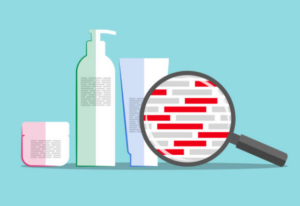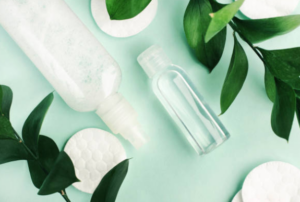Protecting Our Children

In a world where beauty standards are ever-evolving, the use of makeup has become a rite of passage for many, including the younger generation. While the cosmetic industry offers an array of products designed for children and teenagers, there’s a growing concern about the potential risks associated with toxic ingredients in these makeup items. This beauty blog aims to shed light on the impact of toxic makeup on young consumers and explore the importance of making informed choices to protect our children.
The Allure of Makeup for Young Consumers
The enchantment with makeup often begins during childhood and adolescence, as young individuals embark on a journey of self-discovery and expression. The allure of makeup extends beyond the superficial; it becomes a tool for creativity, experimentation, and even a means of building self-confidence.
- Creative Expression:
- For many young consumers, makeup represents an artistic outlet. It serves as a colorful palette to create different looks, experiment with styles, and express their evolving personalities. From experimenting with vibrant eyeshadows to playful lip colors, makeup becomes a form of personal artistry.
- Social Influences:
- The influence of social media and beauty influencers cannot be understated. Platforms like Instagram, TikTok, and YouTube showcase a myriad of makeup trends, inspiring young consumers to try out new looks. The desire to emulate their favorite influencers and celebrities often leads to the exploration of makeup as a means of fitting into beauty standards.
- Peer Pressure and Social Norms:
- As children transition into adolescence, there is often an increased awareness of social norms and a desire to fit in. Makeup can become a tool to conform to these norms, and young individuals may feel pressure to wear it as a way to be accepted or considered ‘grown-up.’ The desire to conform to beauty standards, whether real or perceived, can drive the allure of makeup.
- Boosting Confidence:
- Makeup has the transformative power to boost confidence and self-esteem. Young consumers may use it to enhance features they love, cover perceived flaws, or simply to feel more put together. The ritual of applying makeup can instill a sense of empowerment and contribute to a positive self-image during the often tumultuous teenage years.
- Bonding Moments:
- The application of makeup can also be a bonding experience. Young friends may gather to experiment with different looks, share beauty tips, and create a sense of camaraderie. The social aspect of makeup application fosters a sense of community and shared identity among young consumers.
- Exploration of Identity:
- Adolescence is a time of self-discovery and exploration of identity. Makeup becomes a tool for young individuals to experiment with different facets of their identity, whether it’s trying out bold and edgy looks, embracing a natural aesthetic, or expressing their individuality through unique styles.

Understanding Toxic Ingredients
To make informed choices about the makeup products our young consumers use, it’s imperative to delve deeper into the world of toxic ingredients commonly found in cosmetics. Awareness of these elements empowers parents, caregivers, and young individuals to scrutinize product labels and discern potential health risks.
- Heavy Metals:
- Lead: Perhaps one of the most notorious heavy metals, lead has been found in various cosmetics, including lipsticks and eyeshadows. Exposure to lead is especially concerning for children, as it can lead to developmental delays, cognitive issues, and behavioral problems. Regular use of lead-containing makeup can contribute to the accumulation of this toxic metal in the body over time.
- Mercury: Some skin-lightening creams and eye makeup may contain mercury, a heavy metal with well-documented health risks. Mercury exposure can lead to skin rashes, kidney damage, and, in severe cases, neurological impairment. Young consumers, with their developing systems, are particularly vulnerable to the adverse effects of mercury.
- Synthetic Dyes and Fragrances:
- Allergens and Irritants: Synthetic dyes and fragrances are common culprits in makeup, and they can be sources of skin irritation and allergic reactions. For young individuals with sensitive skin, continuous exposure to these ingredients may lead to redness, itching, and even more severe dermatological issues.
- Phthalates: Often hidden under the term “fragrance,” phthalates are chemicals linked to hormone disruption and reproductive issues. They may be present in various cosmetic products, including fragrances, nail polishes, and hair sprays. Long-term exposure to phthalates is a concern, particularly during crucial developmental stages.
- Formaldehyde and Formaldehyde-Releasing Preservatives:
- Carcinogenic Concerns: Formaldehyde and its releasing agents are used as preservatives in certain cosmetics. Prolonged exposure to formaldehyde is associated with an increased risk of cancer, respiratory issues, and skin sensitivities. Young individuals, with their growing bodies, may be more susceptible to the long-term effects of these carcinogenic substances.
- Parabens:
- Endocrine Disruption: Parabens are synthetic preservatives that mimic estrogen in the body. Their endocrine-disrupting properties raise concerns about potential hormonal imbalances, especially in adolescents undergoing puberty. Parabens are commonly found in various makeup and personal care products.
- Petroleum-Derived Ingredients:
- Contamination Risks: Some cosmetics contain petroleum-derived ingredients, which may be contaminated with impurities like polycyclic aromatic hydrocarbons (PAHs). PAHs are known carcinogens, and their presence in makeup raises health concerns, particularly for young individuals who may use these products daily.
Understanding these toxic ingredients is the first step in making informed choices. Reading product labels, researching the potential risks associated with specific chemicals, and opting for products free from harmful elements become essential practices for those invested in the well-being of young consumers.

Children’s Vulnerable Developing Systems
The impact of toxic makeup on young consumers is amplified by the fact that children are in the midst of crucial developmental stages. Their bodies, including their skin, organs, and physiological systems, are in the process of maturation, rendering them more susceptible to the potential adverse effects of harmful ingredients in cosmetics.
- Skin Absorption Rates:
- Heightened Sensitivity: Children’s skin is more permeable than that of adults. The higher ratio of surface area to body volume, along with thinner skin layers, results in increased absorption rates. Consequently, substances applied to the skin, such as makeup, can be absorbed more readily, potentially leading to a more significant impact on their developing bodies.
- Limited Barrier Function: The skin barrier, which protects against external irritants, is not fully developed in children. This limited barrier function increases the likelihood of chemicals penetrating the skin and entering the bloodstream. This is a critical consideration when evaluating the safety of makeup products applied directly to the skin.
- Organs in Development:
- Vulnerable Organs: Children’s internal organs, including the liver and kidneys, are still developing. These organs play a crucial role in detoxification and elimination processes. Exposure to toxins from makeup, especially those with prolonged or repeated use, may pose a burden on these developing organs, potentially impacting their long-term functionality.
- Neurological Vulnerability: The developing nervous system is particularly vulnerable. Certain toxic ingredients, such as heavy metals like lead, can have neurotoxic effects, potentially interfering with cognitive development and behavior. The impact of such exposures during critical periods of brain development may have lasting consequences.
- Metabolism and Detoxification:
- Metabolic Immaturity: Children’s metabolic systems are not as efficient as those of adults. The ability to metabolize and detoxify substances may be limited, leading to a prolonged presence of certain chemicals in the body. This prolonged exposure can contribute to the cumulative effects of toxic substances.
- Hormonal Susceptibility: The endocrine system, responsible for hormonal regulation, undergoes significant changes during childhood and adolescence. Exposure to endocrine-disrupting chemicals, such as phthalates and parabens, can interfere with hormonal balance and may have implications for reproductive health and overall well-being.
- Developmental Windows of Susceptibility:
- Timing Matters: Certain developmental windows are particularly sensitive to external influences. Exposures during these critical periods can have more pronounced and lasting effects. Makeup used during childhood and adolescence may inadvertently coincide with these vulnerable stages, emphasizing the importance of scrutinizing products during these formative years.
- Behavioral Considerations:
- Ingestion Risks: Young children, especially, may be prone to unintentional ingestion of makeup, either through hand-to-mouth contact or while playing. This raises concerns about the safety of products with toxic ingredients, as ingestion can lead to systemic exposure and potential health risks.

Regulatory Gaps in the Cosmetic Industry
One of the concerning aspects of the issue is the lack of stringent regulations in the cosmetic industry, particularly concerning products marketed to children. Unlike other consumer goods, cosmetics are not subject to pre-market approval by regulatory bodies. This regulatory gap raises questions about the safety of the ingredients used in children’s makeup and the need for stronger measures to protect young consumers.
To better understand the risks associated with toxic makeup, let’s delve into a few case studies where harmful ingredients have been identified in products targeted at children.
- Lead in Lip Products:
- Numerous studies have revealed the presence of lead in lip products, including lipsticks and lip glosses marketed to young consumers. Lead exposure is particularly concerning as it can have detrimental effects on neurological development.
- Formaldehyde in Nail Polishes:
- Some nail polishes designed for children have been found to contain formaldehyde, a known carcinogen. Prolonged exposure to formaldehyde is linked to respiratory issues and an increased risk of certain cancers.
- Fragrance Dangers:
- The term “fragrance” on ingredient lists can encompass a myriad of undisclosed chemicals. Some of these fragrances have been linked to allergies, skin irritation, and respiratory problems, especially in individuals with sensitivities.
In the fight against toxic makeup, education is a powerful tool. Parents and caregivers play a crucial role in safeguarding their children from potentially harmful beauty products. By being informed consumers and scrutinizing product labels, they can make choices that prioritize their child’s health and well-being.
Beyond educating adults, empowering young consumers with knowledge about safe makeup practices is equally important. Teaching them to read ingredient labels, recognize potential hazards, and make conscious choices fosters a sense of autonomy and responsibility. Additionally, promoting positive self-esteem and body image can help reduce the reliance on makeup as a means of validation.
Addressing the issue of toxic makeup requires a collective effort. Advocacy for stricter regulations in the cosmetic industry, especially concerning products marketed to children, is essential. Consumers, parents, and concerned citizens can join forces to demand transparency, accountability, and the prioritization of health over profit.
Amidst the concerns surrounding toxic makeup, a positive shift is underway in the beauty industry. Brands are recognizing the demand for clean, safe alternatives for young consumers. The concept of clean beauty, which focuses on products free from harmful ingredients, is gaining traction. Parents and caregivers can explore these options to ensure their children can enjoy makeup without compromising their health.
In conclusion, the impact of toxic makeup on young consumers is a pressing issue that demands attention and action. As a society, we must advocate for stricter regulations, promote education, and encourage the beauty industry to prioritize the health and well-being of our children. By fostering informed choices, empowering young consumers, and supporting the rise of clean beauty, we can create a future where makeup is not only a form of self-expression but a safe and empowering tool for all. It’s time to redefine beauty standards and ensure that the products our children use contribute to their well-rounded development rather than pose a threat to their health.

